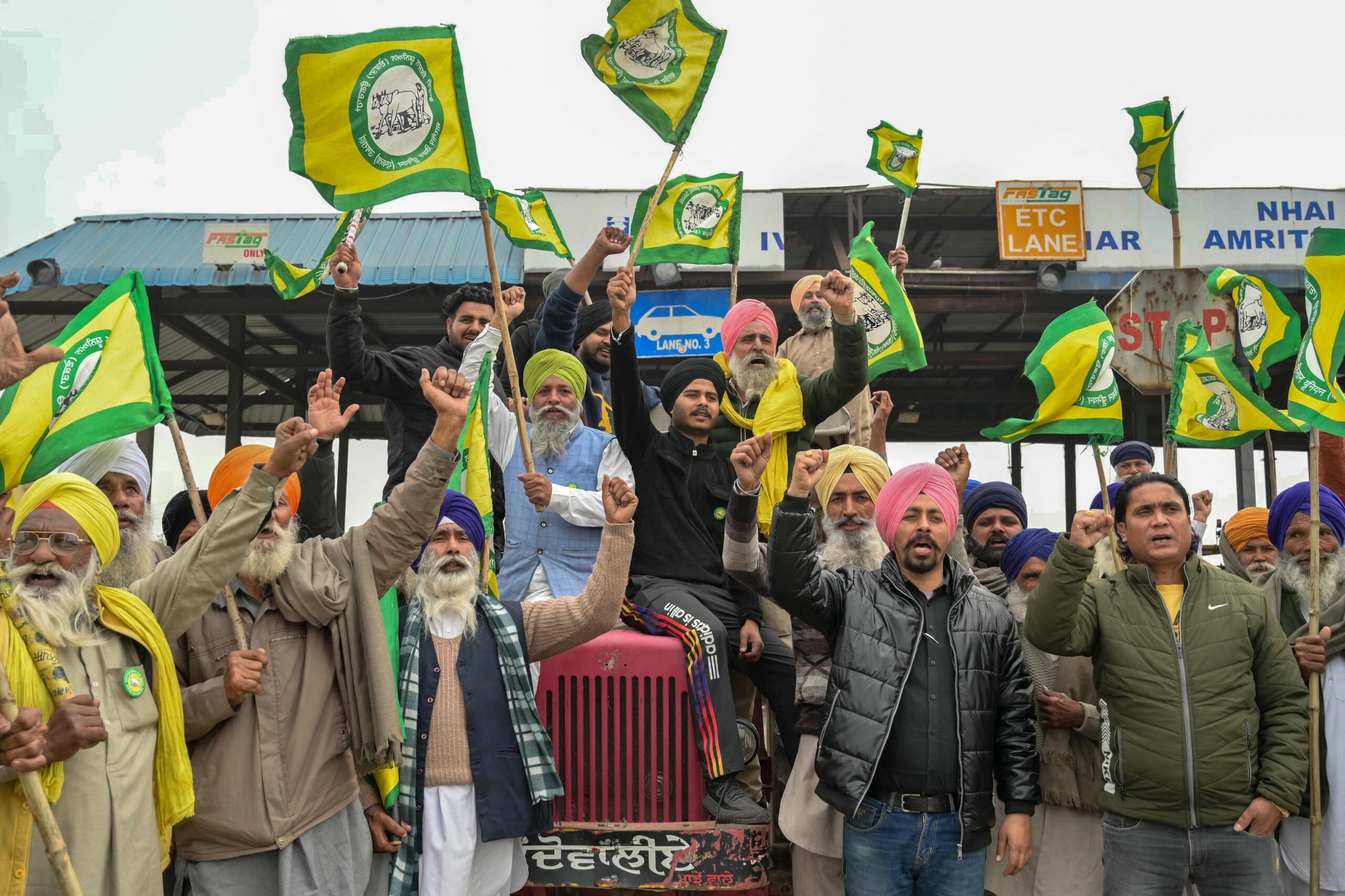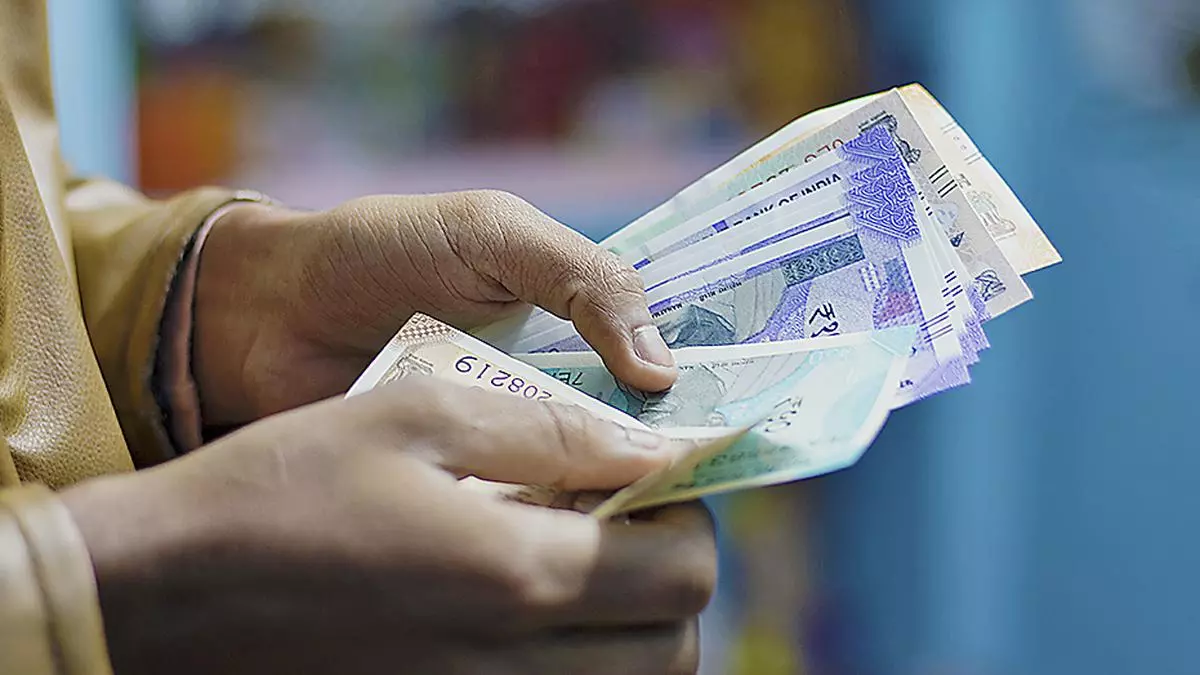Braving a steady stream of tear gas, water cannons, rubber bullets and pellet guns fired by the state police, the protesting farmers managed to break down a few layers of concrete barriers. The angry farmers also uprooted steel spikes which were cemented on the highway to prevent the convoy from entering Haryana. Eventually, they retired for the night following ‘ceasefire’ instructions from union leaders. Hopes were pinned on negotiations with the government, which began a day earlier.
On 18 February, the fourth round of talks took place in Chandigarh, where farm union leaders met three union government representatives—food minister Piyush Goyal, agriculture minister Arjun Munda and junior home minister Nityanand Rai. The government offered what Goyal termed an ‘out of the box’ solution. State agencies will purchase oilseeds, pulses and cotton grown by Punjab farmers at minimum support prices (MSP) for the next five years. The contract farming arrangement will aid growers move away from the wheat-rice cycle which has depleted soils and exhausted groundwater supplies, putting the once prosperous cradle of green revolution at grave risk.
MSP is the price at which the government buys non-perishable produce directly from farmers. So far, it has largely been limited to rice and wheat—because the government needs those grain supplies to run its massive food security scheme. Every year, the government announces support prices for 23 crops, providing a price signal to farmers before they plant.
Farmer leaders, however, rejected the proposal late evening on Monday and said they will push towards Delhi on the morning of 21 February. “We feel the government is not seriously looking at our demands… we are rejecting the offer of MSP-based contract farming. We will wait to hear the government’s proposal on our other demand of a loan waiver,” said Sarvan Singh Pandher, coordinator of Kisan Majdoor Morcha, the coalition of the farmer unions spearheading the agitation.
The backdrop
In November 2020, tens of thousands of farmers had stormed their way into Delhi’s borders, demanding a repeal of three farm laws enacted earlier that year. The laws were introduced to make room for more private sector involvement in purchase, processing and marketing of agricultural produce. The government hoped this would improve crop prices and farm incomes. But growers saw those as a weakening of state support systems. They were particularly worried that the price support scheme, which has continued for six decades, may be tapered down. In November 2021, the government repealed the farm laws following year long protests.
Farmers returned to their villages. But as it appears now, they had unfinished business. The government was yet to consider their other demand—to provide a legal sanctity to MSP. Presently, private buyers are allowed to purchase crops at lower than support prices. The obligation to honour MSPs only rests on the government.
Farmers also want MSPs to be fixed at a higher level, using a comprehensive method of calculating production costs which include the rental value of land.
The centre had set up a panel in July 2022 to suggest ways to make the MSP regime more ‘effective and transparent.’ Farmer unions refused to join the 29-member panel which they claimed were populated with government officials and experts in favour of the repealed farm laws. A year and a half later, the MSP panel is yet to submit its report. And farmers are back on the streets.
The farmer protests come on the backdrop of subdued agricultural production following repeated climate shocks including uneven rainfall last year. The agriculture sector is projected to grow at an estimated 1.8% in 2023-24, compared to a growth of 4% the year before. Farm incomes were also hit by export curbs placed on rice, wheat and onions, as the government rushed to tame consumer prices by reducing import duties. For farmers, who were promised that their incomes will be doubled by 2022—as per a government set target—the crisis of profitability has translated into a rallying cry for revamp of the MSP regime.
The main ask is to make support prices a legal entitlement. That means a stop to trade in grains, pulses and oilseeds below the floor prices announced by the government every year. The demand has sharply divided both public and expert opinion.
According to some, enforcing a minimum price across the country for 23 crops will be a logistical nightmare and impose a heavy burden on government finances. Others say it is a demand hardened by years of apathy hurting farm incomes, but not impossible to implement.
The context

It is dangerous for a country with India’s population (over 1.4 billion) to take food security for granted, said Madhura Swaminathan, professor of economics at the Indian Statistical Institute, Bengaluru. “The support price policy was introduced in the 1960s when India faced a food shortage. It provided the right incentives for farmers to generate a surplus.”
Swaminathan added that this MSP policy, which critics say distorts the market, has not outlived its purpose. Without such a procurement policy in place, the government would not be able to double the quantity of grains supplied to 800 million people under the food security scheme when the covid pandemic hit. It literally saved millions from starvation.
But how reasonable is the demand to make MSP a legal right? “It is not wrong on the part of farmers to expect a minimum or floor price for their produce which ensures reasonable returns. Think of it as (statutory) minimum wages, which even the private sector is supposed to pay,” Swaminathan said.
The other benefit is that a legal backing will allow for more equitable procurement across regions and crops. It can be used as a tool for diversification—to incentivize farmers to grow more pulses and oilseeds where India is deficient.
Currently, farmers from Punjab and Haryana sell their entire marketable surplus to the government, a privilege not available to say, rice growers in Bihar and West Bengal. But they do not corner all benefits of this price policy. Data from National Statistical Office’s Situation Assessment Survey for the year 2018-19 show that 15-19% of paddy growers from across India benefited from MSP purchases. In a poor state like Chhattisgarh, 75% of paddy farmers benefited from MSP. The rural economy of Madhya Pradesh got a facelift following the introduction of MSP-based wheat purchases.
Interestingly, this is not the first time that the issue of a legal backing to MSPs has come to the fore. Back in 2002, a high-level government committee chaired by the late Abhijit Sen on long-term foodgrain policy recommended a statutory status to MSP. It also suggested that costs must be strictly calculated after taking into account the value of unpaid family labour and rental value of land. The committee submitted its report to the Atal Bihari Vajpayee-led Bharatiya Janata Party government. But its recommendations were not implemented.
The calculation
The costs of making MSP a legal right has also become a bone of contention. To enforce MSP across 23 crops, anything between ₹10 trillion and ₹15 trillion would be needed, some estimates have suggested. That would be comparable to the government’s capital expenditure outlay for 2024-25 of ₹11.11 trillion.
However, a recent note by Crisil Research, a ratings agency, stated that if the government implemented a wider MSP policy in 2022-23, it would have needed a working capital of ₹6 trillion. However, since the crops purchased at MSP will also be sold in the market at a later date, the actual cost to the government will be ₹21,000 crore, a modest sum. These costs will shoot up if the government were to supply it by expanding the food security scheme. In this case, the loss will be on account of consumer subsidy.
To arrive at the actual costs, Crisil considered 16 out of 23 field crops, on which MSPs are declared, and which account for 90% of the production. The cost turns out to be modest as only eight out the 16 crops required an intervention—market prices for the rest were higher than respective MSPs.
Such a policy will give farmers the freedom to sow crops of their choice and be more amenable to their local conditions, the note by Crisil stated, adding, “guaranteeing MSP across crops will lead to percolation of the benefit across the country. It will support farmer income and thereby also give a push to consumption demand.”
Going by wholesale crop prices in mid-February, an analysis by Mint shows that only four out of 13 major field crops require any MSP intervention. All four of these are oilseeds—where prices are significantly lower than MSP, not because of abundant domestic supplies but due to a heavy influx of cheap imported cooking oils. A pro-consumer bias in government policy—of curbing exports when international prices are higher and allowing duty free imports—is often referred to as an implicit tax on the Indian farmer.
It’s wrong to say that the government will have to purchase the entire produce when prices of a crop dip below support prices, said Himanshu, associate professor of economics at Jawaharlal Nehru University, Delhi. Not all crops require a price intervention. And even for crops which do, government agencies only need to buy just a portion, say a fifth of the production, to lift market prices higher. As production of pulses and oilseeds are lower by volume (compared to rice and wheat), the procurement required will be lower too.
Himanshu added that MSP is a useful food price stabilization tool for both farmers and consumers. When used effectively, it can keep inflation within tolerable limits and help aid the central bank’s interest rate policy. Lower interest rates, in turn, means lower government spending to service debt.
“That a wider MSP policy will bankrupt the government is a bogey. The same fears were raised when the National Food Security legislation was discussed in 2013.”
The challenge
Physical purchase of crops is not the only option to implement a MSP policy. Previously, the government of Madhya Pradesh experimented with deficiency price payments. Farmers, here, are paid the difference between MSP and market prices, for crops in which market prices are lower than support prices. But some studies showed the scheme was rigged by traders—they would collude to drag market prices lower as farmers would anyway recover their losses from government payments.
Most farm economists do not agree that the government should tinker more with how food markets function. Making way for an MSP law for 23 crops could also lead to producers of fruits, vegetables and milk demanding similar protections.
A Supreme Court appointed committee on farm laws—which had agriculture economists Ashok Gulati and Pramod Joshi as members—suggested a review of price policies in its report submitted to the top court in March 2021.
It recommended a cap on the union government’s purchase of rice and wheat, a larger responsibility for states and allowing beneficiaries of the food subsidy scheme to opt for cash transfers. A cash transfer of food subsidy means that the government will cut down MSP-based purchase of rice and wheat, allowing resources to be diverted to ecologically sustainable crops.
Even if MSP is reframed as a legal right, it will be hard for the government to operationalize it, said Avinash Kishore, senior research fellow at the Delhi office of the International Food Policy Research Institute. “Farmers often perceive markets with distrust and repose more faith in government capacity. Typically, governments are not agile enough to respond to price volatility,” Kishore added.
The other threat is that a legal MSP can drive private buyers away. During a glut, traders may be unwilling to pay farmers a premium over the market clearing price. “It can work in sugarcane (where private mills pay a statutory fair and remunerative price to farmers) because there are a limited number of organized players. But to enforce it on a basket of crops with numerous private buyers is very difficult. It is true that farmers have gotten a raw deal for a long time but an MSP act is not the answer.”
Visit www.cagurujiclasses.com for practical courses











